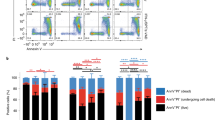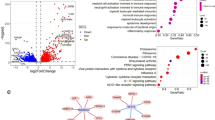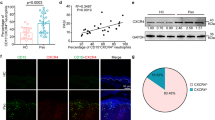Abstract
The SHP-1 protein encoded by the Ptpn6 gene has been extensively studied in hematopoietic cells in the context of inflammation. A point mutation in this gene (Ptpn6spin) causes spontaneous inflammation in mice, which has a striking similarity to neutrophilic dermatoses in humans. Recent findings highlighted the role of signaling adapters and kinases in promoting inflammation in Ptpn6spin mice; however, the underlying transcriptional regulation is poorly understood. Here, we report that SYK is important for driving neutrophil infiltration and initiating wound healing responses in Ptpn6spin mice. Moreover, we found that deletion of the transcription factor Ets2 in myeloid cells ameliorates cutaneous inflammatory disease in Ptpn6spin mice through transcriptional regulation of its target inflammatory genes. Furthermore, Ets-2 drives IL-1α-mediated inflammatory signaling in neutrophils of Ptpn6spin mice. Overall, in addition to its well-known role in driving inflammation in cancer, Ets-2 plays a major role in regulating IL-1α-driven Ptpn6spin-mediated neutrophilic dermatoses.

Model for the role of ETS-2 in neutrophilic inflammation in Ptpn6spin mice. Mutation of the Ptpn6 gene results in SYK phosphorylation which then sequentially activates MAPK signaling pathways and activation of ETS-2. This leads to activation of ETS-2 target genes that contribute to neutrophil migration and inflammation. When Ets2 is deleted in Ptpn6spin mice, the expression of these target genes is reduced, leading to the reduced pathology in neutrophilic dermatoses.
This is a preview of subscription content, access via your institution
Access options
Subscribe to this journal
Receive 12 digital issues and online access to articles
$119.00 per year
only $9.92 per issue
Buy this article
- Purchase on Springer Link
- Instant access to full article PDF
Prices may be subject to local taxes which are calculated during checkout






Similar content being viewed by others
References
Cohen, P. R. Neutrophilic dermatoses: a review of current treatment options. Am. J. Clin. Dermatol. 10, 301–312 (2009).
Callen, J. P. Neutrophilic dermatoses. Dermatol. Clin. 20, 409–419 (2002).
Nesterovitch, A. B. et al. Alteration in the gene encoding protein tyrosine phosphatase nonreceptor type 6 (PTPN6/SHP1) may contribute to neutrophilic dermatoses. Am. J. Pathol. 178, 1434–1441 (2011).
Eriksen, K. W. et al. Deficient SOCS3 and SHP-1 expression in psoriatic T cells. J. Invest. Dermatol. 130, 1590–1597 (2010).
Christophi, G. P. et al. Macrophages of multiple sclerosis patients display deficient SHP-1 expression and enhanced inflammatory phenotype. Lab. Invest. 89, 742–759 (2009).
Zhu, Z. et al. Tyrosine phosphatase SHP-1 in allergic and anaphylactic inflammation. Immunol. Res. 47, 3–13 (2010).
Green, M. C. & Shultz, L. D. Motheaten, an immunodeficient mutant of the mouse. I. Genetics and pathology. J. Hered. 66, 250–258 (1975).
Tsui, H. W., Siminovitch, K. A., de Souza, L. & Tsui, F. W. Motheaten and viable motheaten mice have mutations in the haematopoietic cell phosphatase gene. Nat. Genet. 4, 124–129 (1993).
Nesterovitch, A. B. et al. Spontaneous insertion of a b2 element in the ptpn6 gene drives a systemic autoinflammatory disease in mice resembling neutrophilic dermatosis in humans. Am. J. Pathol. 178, 1701–1714 (2011).
Croker, B. A. et al. Inflammation and autoimmunity caused by a SHP1 mutation depend on IL-1, MyD88, and a microbial trigger. Proc. Natl Acad. Sci. USA 105, 15028–15033 (2008).
Pao, L. I., Badour, K., Siminovitch, K. A. & Neel, B. G. Nonreceptor protein-tyrosine phosphatases in immune cell signaling. Annu Rev. Immunol. 25, 473–523 (2007).
Gurung, P. et al. Tyrosine kinase SYK licenses MyD88 adaptor protein to instigate IL-1alpha-mediated inflammatory disease. Immunity 46, 635–648 (2017).
Lukens, J. R. et al. RIP1-driven autoinflammation targets IL-1alpha independently of inflammasomes and RIP3. Nature 498, 224–227 (2013).
Tartey, S., Gurung, P., Dasari, T. K., Burton, A. & Kanneganti, T. D. ASK1/2 signaling promotes inflammation in a mouse model of neutrophilic dermatosis. J. Clin. Invest. 128, 2042–2047 (2018).
Tartey, S., Gurung, P., Samir, P., Burton, A. & Kanneganti, T. D. Cutting Edge: dysregulated CARD9 signaling in neutrophils drives inflammation in a mouse model of neutrophilic dermatoses. J. Immunol. 201, 1639–1644 (2018).
Abram, C. L., Roberge, G. L., Pao, L. I., Neel, B. G. & Lowell, C. A. Distinct roles for neutrophils and dendritic cells in inflammation and autoimmunity in motheaten mice. Immunity 38, 489–501 (2013).
Mocsai, A., Ruland, J. & Tybulewicz, V. L. The SYK tyrosine kinase: a crucial player in diverse biological functions. Nat. Rev. Immunol. 10, 387–402 (2010).
Mocsai, A., Zhou, M., Meng, F., Tybulewicz, V. L. & Lowell, C. A. Syk is required for integrin signaling in neutrophils. Immunity 16, 547–558 (2002).
Mocsai, A. et al. G-protein-coupled receptor signaling in Syk-deficient neutrophils and mast cells. Blood 101, 4155–4163 (2003).
Zhong, X., Chen, B., Yang, L. & Yang, Z. Molecular and physiological roles of the adaptor protein CARD9 in immunity. Cell Death Dis. 9, 52 (2018).
Roth, S. & Ruland, J. Caspase recruitment domain-containing protein 9 signaling in innate immunity and inflammation. Trends Immunol. 34, 243–250 (2013).
Ghosh, D., Tsokos, G. C. & Kyttaris, V. C. c-Jun and Ets2 proteins regulate expression of spleen tyrosine kinase in T cells. J. Biol. Chem. 287, 11833–11841 (2012).
Krishnan, S. et al. Differential expression and molecular associations of Syk in systemic lupus erythematosus T cells. J. Immunol. 181, 8145–8152 (2008).
Wei, G. et al. Activated Ets2 is required for persistent inflammatory responses in the motheaten viable model. J. Immunol. 173, 1374–1379 (2004).
Tecchio, C., Micheletti, A. & Cassatella, M. A. Neutrophil-derived cytokines: facts beyond expression. Front. Immunol. 5, 508 (2014).
Di Paolo, N. C. & Shayakhmetov, D. M. Interleukin 1alpha and the inflammatory process. Nat. Immunol. 17, 906–913 (2016).
Rider, P. et al. IL-1alpha and IL-1beta recruit different myeloid cells and promote different stages of sterile inflammation. J. Immunol. 187, 4835–4843 (2011).
Quinn, S. R. et al. The role of Ets2 transcription factor in the induction of microRNA-155 (miR-155) by lipopolysaccharide and its targeting by interleukin-10. J. Biol. Chem. 289, 4316–4325 (2014).
Tonks, N. K. Protein tyrosine phosphatases: from genes, to function, to disease. Nat. Rev. Mol. Cell Biol. 7, 833–846 (2006).
Cao, H. & Hegele, R. A. Identification of polymorphisms in the human SHP1 gene. J. Hum. Genet. 47, 445–447 (2002).
Christophi, G. P. et al. SHP-1 deficiency and increased inflammatory gene expression in PBMCs of multiple sclerosis patients. Lab. Invest. 88, 243–255 (2008).
Dubois, M. J. et al. The SHP-1 protein tyrosine phosphatase negatively modulates glucose homeostasis. Nat. Med. 12, 549–556 (2006).
Geraldes, P. et al. Activation of PKC-delta and SHP-1 by hyperglycemia causes vascular cell apoptosis and diabetic retinopathy. Nat. Med. 15, 1298–1306 (2009).
Robinson, M. J. et al. Dectin-2 is a Syk-coupled pattern recognition receptor crucial for Th17 responses to fungal infection. J. Exp. Med. 206, 2037–2051 (2009).
Gringhuis, S. I. et al. Dectin-1 directs T helper cell differentiation by controlling noncanonical NF-kappaB activation through Raf-1 and Syk. Nat. Immunol. 10, 203–213 (2009).
Yamada, T. et al. IL-1 induced chemokine production through the association of Syk with TNF receptor-associated factor-6 in nasal fibroblast lines. J. Immunol. 167, 283–288 (2001).
Baran, C. P. et al. Transcription factor ets-2 plays an important role in the pathogenesis of pulmonary fibrosis. Am. J. Respir. Cell Mol. Biol. 45, 999–1006 (2011).
Trojanowska, M. Ets factors and regulation of the extracellular matrix. Oncogene 19, 6464–6471 (2000).
Yang, H. et al. ETS family transcriptional regulators drive chromatin dynamics and malignancy in squamous cell carcinomas. Elife 4, e10870 (2015).
Sementchenko, V. I. & Watson, D. K. Ets target genes: past, present and future. Oncogene 19, 6533–6548 (2000).
Yamamoto, H. et al. Defective trophoblast function in mice with a targeted mutation of Ets2. Genes Dev. 12, 1315–1326 (1998).
Saijo, K. et al. Essential role of Src-family protein tyrosine kinases in NF-kappaB activation during B cell development. Nat. Immunol. 4, 274–279 (2003).
Pao, L. I. et al. B cell-specific deletion of protein-tyrosine phosphatase Shp1 promotes B-1a cell development and causes systemic autoimmunity. Immunity 27, 35–48 (2007).
Clausen, B. E., Burkhardt, C., Reith, W., Renkawitz, R. & Forster, I. Conditional gene targeting in macrophages and granulocytes using LysMcre mice. Transgenic Res. 8, 265–277 (1999).
Passegue, E., Wagner, E. F. & Weissman, I. L. JunB deficiency leads to a myeloproliferative disorder arising from hematopoietic stem cells. Cell 119, 431–443 (2004).
Acknowledgements
We would like to thank Dr. Yury Miller for the Sykfl/fl mice and Dr. Bruce Beutler for the Ptpn6 mutant mice. We would like to thank the members of the Kanneganti lab for their comments and suggestions and Rebecca Tweedell, PhD, for scientific editing. This work was supported by the K22 NIAID Career Transition Award AI127836 to P.G., the National Institutes of Health grants CA163507, AR056296, AI124346 and AI101935 and by the American Lebanese Syrian Associated Charities to T.-D.K.
Author information
Authors and Affiliations
Contributions
S.T. and T.-D.K. conceptualized the study; S.T. designed the experiments; S.T., P.G., R.K. and A.B. performed the experiments; P.H. provided Ets2fl/fl mice; and S.T. analyzed the data and wrote the paper. All authors critically evaluated and edited the paper and approved the final version. T.-D.K. oversaw the project.
Corresponding author
Ethics declarations
Competing interests
The authors declare no competing interests.
Supplementary information
Rights and permissions
About this article
Cite this article
Tartey, S., Gurung, P., Karki, R. et al. Ets-2 deletion in myeloid cells attenuates IL-1α-mediated inflammatory disease caused by a Ptpn6 point mutation. Cell Mol Immunol 18, 1798–1808 (2021). https://doi.org/10.1038/s41423-020-0398-7
Received:
Accepted:
Published:
Issue Date:
DOI: https://doi.org/10.1038/s41423-020-0398-7
Keywords
This article is cited by
-
Discovering therapeutic possibilities for polycystic ovary syndrome by targeting XIST and its associated ceRNA network through the analysis of transcriptome data
Scientific Reports (2024)
-
A distal super-enhancer activates oncogenic ETS2 via recruiting MECOM in inflammatory bowel disease and colorectal cancer
Cell Death & Disease (2023)



